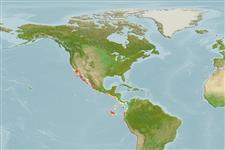>
Argentiniformes (Marine smelts) >
Microstomatidae (Pencil smelts)
Eponymy: Fridtjof Nansen (1861–1930) was a Norwegian explorer, scientist, diplomat and later recipient of the Nobel Peace Prize. [...] (Ref. 128868), visit book page.
Environment: milieu / climate zone / depth range / distribution range
Ökologie
seewasser benthopelagisch; tiefenbereich 0 - 865 m (Ref. 5123). Subtropical; 35°N - 7°S
Eastern Pacific: southern region of California Current south of 35°N.
Size / Gewicht / Alter
Maturity: Lm ? range ? - ? cm
Max length : 26.6 cm SL (female)
Kurzbeschreibung
Bestimmungsschlüssel | Morphologie | Morphometrie
Rückenflossenstacheln (insgesamt) : 0; Rückenflossenweichstrahlen (insgesamt) : 9 - 10; Afterflossenstacheln: 0; Afterflossenweichstrahlen: 8 - 9; Wirbelzahl: 43 - 46. Branchiostegal rays 4. Predorsal length greater than 49% SL. Caudal peduncle length greater than 13% SL; depth less than 8% SL in specimens more than 3 cm (Ref. 5123).
Adults are found in continental slope regions. Oviparous, with planktonic eggs and larvae (Ref. 35612). Larvae and juveniles pelagic in the upper 200-m layer and more broadly distributed than adults (Ref. 5123).
Life cycle and mating behavior
Geschlechtsreife | Fortpflanzung | Ablaichen | Eier | Fecundity | Larven
Moser, H.G. and J.L. Butler, 1996. Microstomatidae: argentines and pencilfishes. p. 208-215. In H.G. Moser (ed.) The early stages of fishes in the California Current Region. California Cooperative Oceanic Fisheries Investigations (CalCOFI) Atlas No. 33. 1505 p. (Ref. 35612)
IUCN Rote Liste Status (Ref. 130435: Version 2024-1)
Bedrohung für Menschen
Harmless
Nutzung durch Menschen
Tools
Zusatzinformationen
Download XML
Internet Quellen
Estimates based on models
Preferred temperature (Ref.
123201): 7.8 - 14.8, mean 11.4 °C (based on 35 cells).
Phylogenetic diversity index (Ref.
82804): PD
50 = 0.5000 [Uniqueness, from 0.5 = low to 2.0 = high].
Bayesian length-weight: a=0.00389 (0.00180 - 0.00842), b=3.12 (2.94 - 3.30), in cm total length, based on all LWR estimates for this body shape (Ref.
93245).
Trophic level (Ref.
69278): 3.4 ±0.4 se; based on size and trophs of closest relatives
Fishing Vulnerability (Ref.
59153): Low vulnerability (22 of 100).
